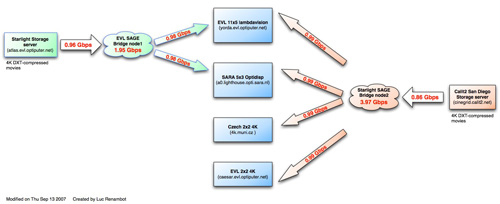New Distributed High-Performance Pixel Streaming Feature Announced at GLIF Conference in Prague
Chicago, IL, September 20, 2007 -- Earlier this week at the 7th Annual Global LambdaGrid Workshop in Prague, the Global Lambda Visualization Facility (GLVF), an international team of computer and application scientists, announced the results of a distributed pixel streaming experiment using the new Visualcasting feature of the Scalable Adaptive Graphics Environment (SAGE).
|
SAGE is the GLVF-adopted middleware developed by the University of Illinois at Chicago (UIC) Electronic Visualization Laboratory (EVL) that allows its users to simultaneously view and interact with multiple streams of high-resolution content, including stored scientific-visualization movies, real-time generated visualizations of computational simulations, and camera-based streams.
SAGE enables individual sites to generate visualizations and animations using in-house specialized and/or proprietary hardware and software, and then send streams of pixel information to a partner site so collaborators can see the results. Visualcasting extends this capability to multiple networked users by replicating the streams to multiple sites simultaneously, enabling partners to collaboratively work in a shared session.
For this experiment, multi-gigabit, high-resolution scientific visualizations were streamed from data stores in San Diego and Chicago to tiled display walls in Chicago, Amsterdam and Brno (Czech Republic). Two different animations were streamed; one was sent to four locations, and the other was sent to two locations. Each endpoint ran SAGE to send and/or receive the real-time streams.
|
The participating GLVF sites were SARA, the Computing and Networking Services supercomputer center in the Netherlands; Masaryk University in Brno, Czech Republic; and StarLight, EVL and Calit2 in the USA. StarLight and Calit2 hosted data servers where the information was stored. SARA, Masaryk and EVL each ran SAGE to access and send and/or receive real-time streams of ultra-high-resolution 2D and 3D content.
From San Diego to StarLight in Chicago, the UIC-private lightpath CAVEwave, deployed on the National LambdaRail, was used. EVL connects to StarLight using State of Illinois I-WIRE optical fiber. From StarLight, connectivity to SARA was made via the NSF-funded TransLight/StarLight network infrastructure, and connectivity to Masaryk was made via the 10Gbps CESNET connection to Prague and then to Brno.
SAGE enables researchers to create real-time shared “Cyber-mash-ups.” A mash-up is a fusion of data from multiple sources into an integrated web experience in ways not envisioned by the original data providers. A Cyber-mash-up combines and integrates data from both web-accessible public databases as well as very-large-scale data repositories of cyber-observatories, such as astronomical images, U.S. Geological Survey maps or NASA climate models.
Visualcasting is application-centric, enabling researchers to dynamically create their own virtual laboratories for global collaboration. This is an important advancement over traditional network multicasting, which is currently used to send streams to multiple sites simultaneously; however, multicasting is not automatically supported by today’s networking infrastructure and requires network engineering to implement.
The GLVF Visualcasting experiment used resources allocated by the Global Lambda Integrated Facility (GLIF), a global-scale cooperative in support of high-performance computational science. GLIF’s mission is to provide bandwidth, which has already been apportioned as lambdas (lightwaves that carry data traffic), for scheduled application and middleware research.
UIC’s EVL is among the GLIF founding members and also heads the GLVF. EVL’s contributions include gigabit networked visualization systems and user-interface frameworks used by both groups.
SAGE, developed as part of the NSF-funded OptIPuter project, is one of many next-generation tools of interest to the GLIF community and non-scientific user groups alike. GLVF participants also support the activities of CineGrid.org, an interdisciplinary community that focuses on digital cinema research and development over optical networks. SAGE’s streaming and visualcasting capabilities are already being explored as a framework for digital cinema exchange and distribution over photonic networks.
The 7th Annual Global LambdaGrid Workshop was held in Prague, September 17-18, to discuss the latest technical challenges and application requirements of a globally integrated, and cooperatively managed, collection of multi-gigabit networks in support of data-intensive scientific research. Organized by GLIF, the workshop participants included the world’s leading networking managers and engineers, middleware developers, application scientists, and network industry leaders.
About Scalable Adaptive Graphics Environment (SAGE)
SAGE is an integrated system used to simultaneously display multiple networked applications on high-resolution tiled displays. The SAGE architecture uses distributed rendering clusters connected by high-bandwidth networks to stream multiple applications to a class of scalable tiled displays that are fast becoming a standard for scientific distance collaboration. Using SAGE, several applications—including high-resolution 2D imagery, 3D computer graphics and high definition video—can be streamed and viewed simultaneously. SAGE is being developed by the Electronic Visualization Laboratory at the University of Illinois at Chicago as part of the NSF-funded OptIPuter project.
Related Links
SAGE
Global Lambda Virtual Facility (GLVF)
SARA
Masaryk University
Electronic Visualization Laboratory, University of Illinois at Chicago
StarLight
National LambdaRail
I-Wire
CESNET
CineGrid
Global Lambda Integrated Facility (GLIF)
Media Contacts
Media Contact: Laura Wolf, Electronic Visualization Laboratory, University of Illinois at Chicago, laura @ evl.uic.edu



